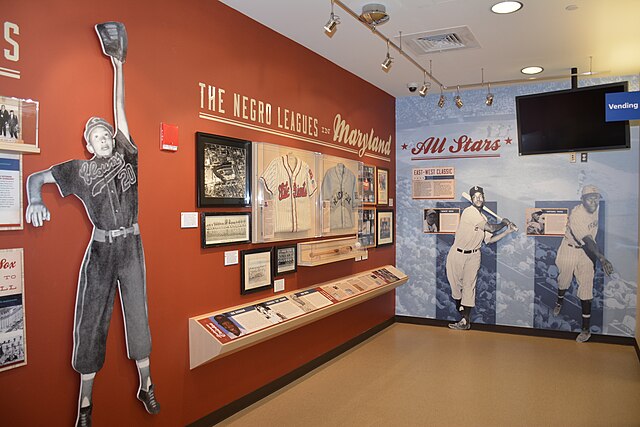
By Darius Brockett, Special to the AFRO
The Hubert V. Simmons Museum of Negro Leagues Baseball in Baltimore tells a unique story in an eccentric way. Located inside of the Baltimore County Public Library (BCPL) in Owings Mills, Md., the museum spreads throughout multiple floors within the building.
In 2008 Hubert V. “Bert” Simmons, alongside his wife Audrey L. Simmons and good friend Rayner “Ray” Banks, set plans to open the museum in the basement meeting hall of Lochearn Presbyterian Church.
In November 2013, then Baltimore County Executive Kevin Kamenetz gave the museum a permanent location inside of the Owings Mills Metro Centre Complex. In spring 2014 the grand opening of the Hubert V. Simmons Museum of Negro Leagues Baseball was held inside of the building.
But this is no traditional museum. Upon walking in, the name of the museum is on the ceiling with photos hanging down. The introduction of the museum starts in the right corner to show its origins. As one walks onto the elevator and gets off you are immediately graced with Negro League history and artifacts.
“You’ll see the different beginnings of Negro League history from the 1920s,” said co-founder and Nego League Ambassador Rayner ‘Ray’ Banks.
The museum does not just tell the history of the sport alone, but also chronicles the legacy of unsung heroes and heroines.
Executive Director Peter Brooks talked about this museum leaving a legacy for those who go unmentioned and who’ve made a serious impact.
“This museum is an opportunity to continue the legacy and make sure that they did not live their lives in vain– the stories of the people from the Caribbean who played in the Negro Leagues, the stories of the women who teams in the Negro Leagues and played in the Negro Leagues, the Israelites who played in the Negro Leagues,” said Brooks.
Brooks, the grandson of musician Cab Calloway, told stories about how his grandfather owned and often played games with his Negro League baseball team.
Baltimore is a foundational part of America’s history and the country’s favorite pastime. Charm City housed two Negro League Baseball teams. The Elite Giants and the Baltimore Black Sox both played games in East Baltimore.
“A lot happened here,” said Brooks. “The Negro Leagues were at the center of the Civil Rights Movement. So, it’s really important that Maryland– and Baltimore–acknowledge these things.”
The second Saturday in the month of May is Negro League Day in the state of Maryland. This is in thanks to Banks’ daughter, Tanya Thomas, who helped gather people to testify and get a bill passed to celebrate Negro League Baseball. On May 7, 2009, a bill was passed to commemorate the Negro league here in Maryland.
There is also a national call being made by descendants of former players to make officially May 2, “Negro Leagues Day.” The day would mark the date of the first game played by two teams in the Negro Leagues, the Indianapolis ABCs and the Chicago Giants.
This year on May 13, the Baltimore Orioles will be highlighting the museum at Camden Yard and hosting a special guest pitcher.
Currently, the museum is planning to add another exhibit on the fourth floor. Although they do not have any future events planned currently, ambition is high.
The museum has done film screenings, holds social events and is at the Maryland State Fair each year.
“One of my many dreams is to react and reenact some of those things. If I can get a stadium [to] reenact what took place, [I would] have somebody throw a black hat on the field like they did Jackie Robinson,” said Banks.
Banks wants to recreate an authentic Negro League Baseball game from down to even the halftime performance from creative giants like Louis Armstrong or Cab Calloway playing as they did back in the day.
Both Brooks and Banks also have hope that Negro League Baseball will become part of a school’s curriculum.
The Hubert V. Simmons Museum of Negro Leagues Baseball is open during Baltimore County Public Library hours, located at 10302 Grand Central Ave in Owing Mills, MD.


